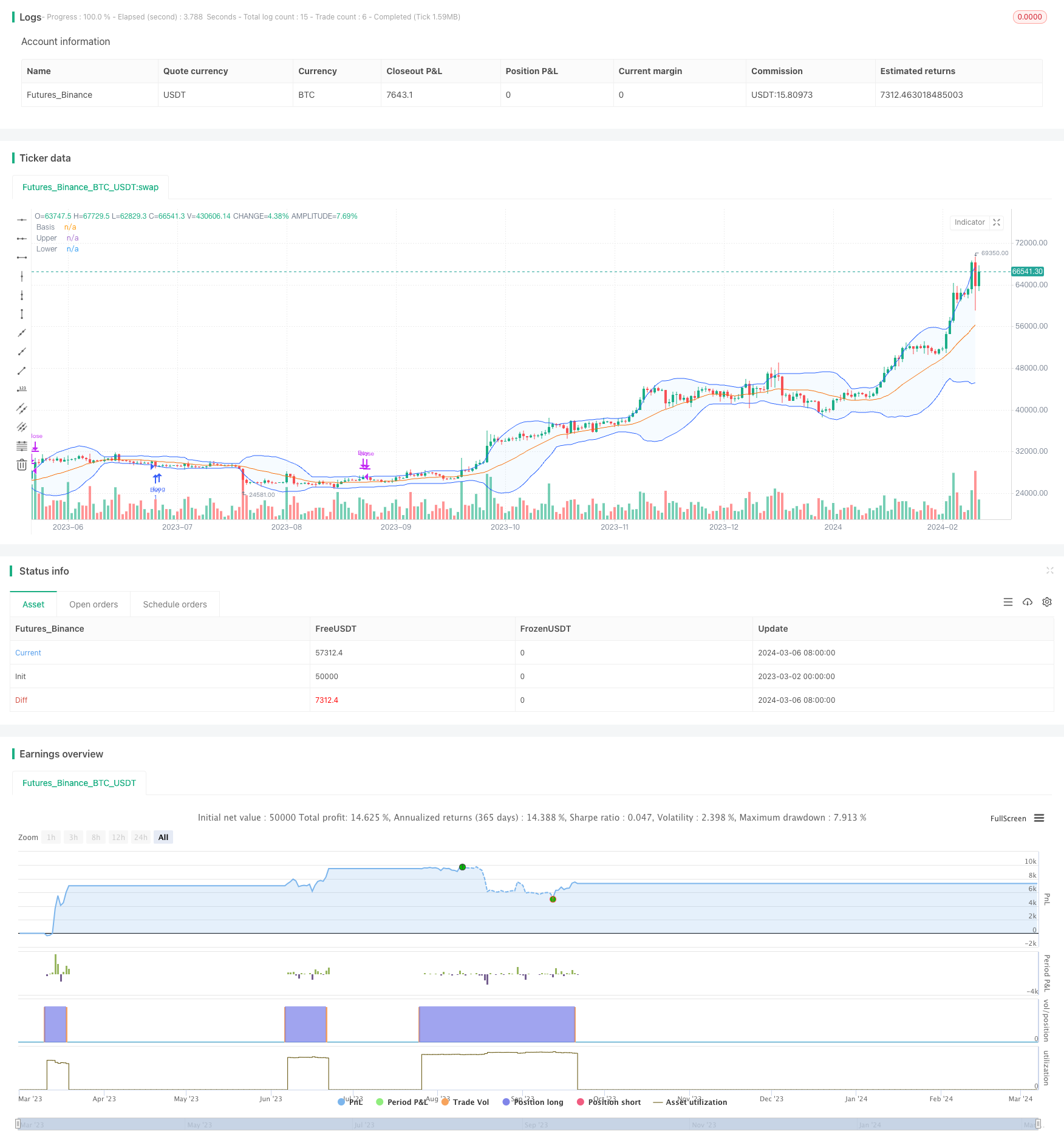
概述
布林带均值回归策略是一个基于布林带指标的量化交易策略。该策略利用了价格围绕均线波动的统计规律,通过在价格偏离布林带上下轨时进行反向操作,以期获得价格回归均值时的利润。
策略原理
布林带由三条线组成:中轨是移动平均线,上下轨是在中轨基础上加减一定倍数的标准差。根据统计学原理,在正态分布的情况下,约有95%的数值会分布在距离平均值正负两个标准差的范围内。
布林带均值回归策略正是利用了这一原理。当价格上穿布林带上轨,表明价格可能过高,存在回落风险;当价格下穿布林带下轨,表明价格可能过低,存在反弹机会。因此,该策略在价格触及布林带上轨时做空,在触及下轨时做多,以期捕捉价格回归均值的利润空间。
该策略代码的主要逻辑如下:
计算指定周期的移动平均线,作为布林带的中轨。可选择SMA、EMA、SMMA、WMA、VWMA等不同类型的均线。
计算价格在该周期内的标准差,并结合用户设定的倍数参数,得到布林带的上下轨。
当收盘价上穿布林带上轨时,触发卖出信号;当收盘价下穿布林带下轨时,触发买入信号。
策略执行交易:买入信号触发时开多仓,直到卖出信号出现时平仓。
通过以上过程,策略能够在价格显著偏离均线时建立反向头寸,并在价格回归均值时获利了结。
优势分析
布林带均值回归策略具有以下优势:
逻辑简单,易于理解和实现。该策略基于统计学的基本原理,通过布林带对价格的波动范围进行刻画,入场和出场条件清晰明确。
适应性强,可应用于多个市场和品种。布林带是一个通用性很强的技术指标,对于趋势性和震荡性的市场都有一定的适应能力。用户可以灵活调整参数,以适应不同的市场特征。
捕捉价格波动的机会。布林带扩张和收缩体现了价格的波动情况,该策略通过在价格达到相对高位或低位时建仓,力图获取价格回归均值的收益。
止盈止损相对明确。由于布林带对应了一定的置信区间,因此该策略的止盈止损位置相对容易确定,有助于控制风险。
风险分析
尽管布林带均值回归策略有其优势,但同时也存在一定的风险:
趋势性市场中表现欠佳。如果市场出现连续的单边趋势,价格持续在布林带上轨或下轨附近运行,该策略可能会频繁出现亏损交易。
参数设置敏感。布林带的周期和倍数参数对策略表现有显著影响,不同的参数组合可能导致截然不同的结果。如果参数设置不当,策略的有效性会大打折扣。
面临频繁震荡的风险。当市场波动率较大,价格在布林带上下轨之间频繁震荡时,该策略可能会出现连续的小额亏损,导致整体收益率下降。
未考虑交易成本。该示例代码并未考虑点差、手续费等交易成本因素,在实际应用中,这些因素会一定程度上影响策略的净收益。
针对以上风险,可以考虑采取以下措施来优化策略:
结合趋势指标进行过滤。在判断信号时,可以辅助使用如移动平均线等趋势指标,以避免在单边趋势中频繁交易。
优化参数选择。通过对历史数据进行回测,分析不同参数组合下策略的表现,选择适合当前市场的最优参数。定期进行参数评估和调整。
引入其他过滤条件。如考虑ATR等波动率指标,在波动率过高时暂停交易;或参考交易量等其他指标,进一步确认信号的可靠性。
纳入交易成本因素。在回测和实盘中,应将点差、手续费等交易成本计算在内,以更准确地评估策略的实际表现。
优化方向
除了上述提到的风险应对措施外,还可以从以下方面对布林带均值回归策略进行优化:
动态调整参数。根据市场的变化,动态调整布林带的周期和倍数参数。可以考虑使用适应性均线(如KAMA)作为中轨,或根据ATR等指标动态调整倍数参数,以适应当前的市场节奏。
引入多空仓位管理。在开仓时,可以根据价格与布林带中轨的距离,动态调整仓位大小。离中轨越远,开仓比例可以适当减小,以控制风险;离中轨越近,开仓比例可以适当增加,以抓住更多机会。
结合其他技术指标。将布林带与其他技术指标(如RSI、MACD等)结合使用,形成更加稳健的信号确认机制。只有在多个指标共振时才进行交易,提高信号的可靠性。
考虑多头寸管理。在适当的条件下,可以同时持有多个头寸,分散风险。例如,可以在不同的时间周期上应用该策略,或在不同的交易品种上同时开仓,以获得更加稳健的收益。
这些优化措施的目的是提高策略的适应性、稳健性和盈利能力。通过动态调整、多指标结合、仓位管理等手段,可以更好地应对市场变化,控制风险,捕捉更多的交易机会。
总结
布林带均值回归策略是一个基于统计原理的量化交易策略,通过布林带对价格的波动范围进行刻画,在价格偏离上下轨时进行反向操作,以期获得均值回归的收益。该策略逻辑简单,适应性强,能够捕捉价格波动的机会,但同时也面临趋势性市场表现欠佳、参数设置敏感、频繁震荡等风险。
针对这些风险,可以通过结合趋势指标、优化参数选择、引入其他过滤条件、纳入交易成本等措施来进行优化。此外,还可以通过动态调整参数、多空仓位管理、结合其他技术指标、多头寸管理等方式,进一步提升策略的适应性和稳健性。
总的来说,布林带均值回归策略为量化交易提供了一种简单而有效的思路。在实际应用中,需要根据具体的市场特点和交易需求,对策略进行适当的优化和改进。通过不断的测试和调整,寻找最适合自己的交易方式,才能在量化交易的道路上取得长期的成功。
/*backtest
start: 2023-03-02 00:00:00
end: 2024-03-07 00:00:00
period: 1d
basePeriod: 1h
exchanges: [{"eid":"Futures_Binance","currency":"BTC_USDT"}]
*/
//@version=5
strategy("BB Strategy", shorttitle="BB", overlay=true)
length = input.int(20, minval=1)
maType = input.string("SMA", "Basis MA Type", options = ["SMA", "EMA", "SMMA (RMA)", "WMA", "VWMA"])
src = input(close, title="Source")
mult = input.float(2.0, minval=0.001, maxval=50, title="StdDev")
// Calculate moving average based on selected type
ma(source, length, _type) =>
switch _type
"SMA" => ta.sma(source, length)
"EMA" => ta.ema(source, length)
"SMMA (RMA)" => ta.rma(source, length)
"WMA" => ta.wma(source, length)
"VWMA" => ta.vwma(source, length)
// Calculate Bollinger Bands
basis = ma(src, length, maType)
dev = mult * ta.stdev(src, length)
upper = basis + dev
lower = basis - dev
// Plot Bollinger Bands
plot(basis, "Basis", color=#FF6D00)
p1 = plot(upper, "Upper", color=#2962FF)
p2 = plot(lower, "Lower", color=#2962FF)
fill(p1, p2, title = "Background", color=color.rgb(33, 150, 243, 95))
// Buy condition: Price below lower Bollinger Band
buy_condition = close < lower
// Sell condition: Price above upper Bollinger Band
sell_condition = close > upper
// Execute trades
strategy.entry("Buy", strategy.long, when=buy_condition)
strategy.close("Buy", when=sell_condition)